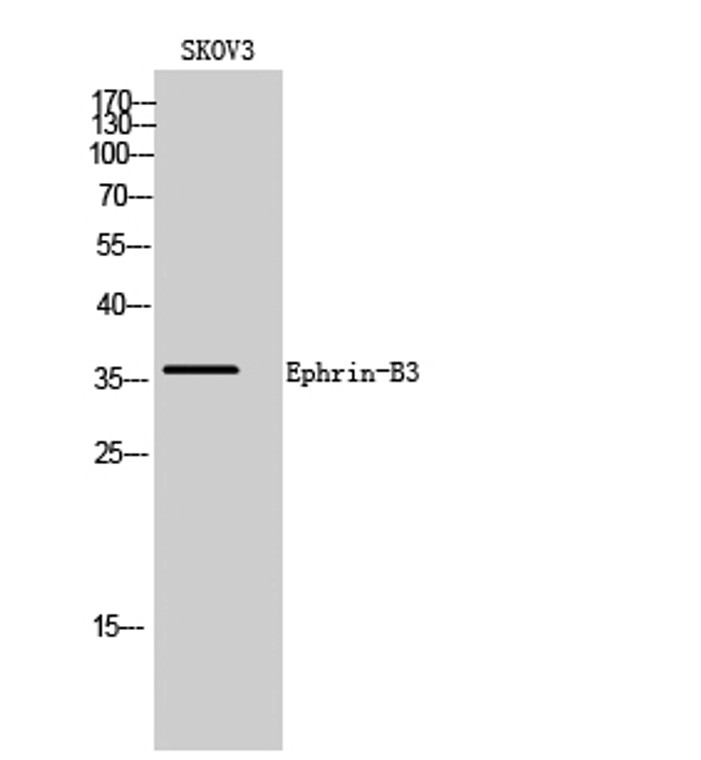| Host: |
Rabbit |
| Applications: |
WB/IHC/IF/ELISA |
| Reactivity: |
Human/Mouse/Rat |
| Note: |
STRICTLY FOR FURTHER SCIENTIFIC RESEARCH USE ONLY (RUO). MUST NOT TO BE USED IN DIAGNOSTIC OR THERAPEUTIC APPLICATIONS. |
| Short Description: |
Rabbit polyclonal antibody anti-Ephrin-B3 (221-270 aa) is suitable for use in Western Blot, Immunohistochemistry, Immunofluorescence and ELISA research applications. |
| Clonality: |
Polyclonal |
| Conjugation: |
Unconjugated |
| Isotype: |
IgG |
| Formulation: |
Liquid in PBS containing 50% Glycerol, 0.5% BSA and 0.02% Sodium Azide. |
| Purification: |
The antibody was affinity-purified from rabbit antiserum by affinity-chromatography using epitope-specific immunogen. |
| Concentration: |
1 mg/mL |
| Dilution Range: |
WB 1:500-1:2000IHC 1:100-1:300ELISA 1:20000IF 1:50-200 |
| Storage Instruction: |
Store at-20°C for up to 1 year from the date of receipt, and avoid repeat freeze-thaw cycles. |
| Gene Symbol: |
EFNB3 |
| Gene ID: |
1949 |
| Uniprot ID: |
EFNB3_HUMAN |
| Immunogen Region: |
221-270 aa |
| Specificity: |
Ephrin-B3 Polyclonal Antibody detects endogenous levels of Ephrin-B3 protein. |
| Immunogen: |
The antiserum was produced against synthesized peptide derived from the human EFNB3 at the amino acid range 221-270 |
| Function | Cell surface transmembrane ligand for Eph receptors, a family of receptor tyrosine kinases which are crucial for migration, repulsion and adhesion during neuronal, vascular and epithelial development. Binds promiscuously Eph receptors residing on adjacent cells, leading to contact-dependent bidirectional signaling into neighboring cells. The signaling pathway downstream of the receptor is referred to as forward signaling while the signaling pathway downstream of the ephrin ligand is referred to as reverse signaling. May play a pivotal role in forebrain function. Binds to, and induce the collapse of, commissural axons/growth cones in vitro. May play a role in constraining the orientation of longitudinally projecting axons. (Microbial infection) Acts as a receptor for nipah virus and hendra virus. |
| Protein Name | Ephrin-B3Eph-Related Receptor Transmembrane Ligand Elk-L3Eph-Related Receptor Tyrosine Kinase Ligand 8Lerk-8 |
| Database Links | Reactome: R-HSA-2682334Reactome: R-HSA-3928662Reactome: R-HSA-3928664Reactome: R-HSA-3928665 |
| Cellular Localisation | MembraneSingle-Pass Type I Membrane Protein |
| Alternative Antibody Names | Anti-Ephrin-B3 antibodyAnti-Eph-Related Receptor Transmembrane Ligand Elk-L3 antibodyAnti-Eph-Related Receptor Tyrosine Kinase Ligand 8 antibodyAnti-Lerk-8 antibodyAnti-EFNB3 antibodyAnti-EPLG8 antibodyAnti-LERK8 antibody |
Information sourced from Uniprot.org
12 months for antibodies. 6 months for ELISA Kits. Please see website T&Cs for further guidance









